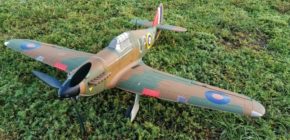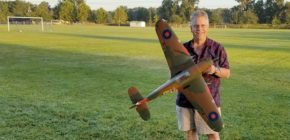Most of the planes I fly are the small, lightweight Park Flyers. Any crashes have been easily repaired with glue and scotch tape.
The only exception was my ill-fated Mitsubishi Zero model. A balsa and plywood model kit with a wingspan of about 40″, it was larger, heavier and more unstable than my other models. My efforts to fly it resulted in 2 quick crashes. The construction log and final flight of the Zero is illustrated in the “Models that Fly” section of Hobbies and Pasttimes.
Way back in July, (while the Zero was still under construction), I stopped by Rob’s Hobby Shop in Ocala for glue or something and saw a beautiful model of a Hawker Hurricane hanging from the ceiling. It was being sold on consignment for half the cost of a new one — a deal I found difficult to pass up. It had a tremendous amount of detail for a foam model, but with a 48″ wingspan, I knew I wasn’t ready to fly something that large and relatively heavy — yet.
Last week, I installed a receiver, balanced the model around it’s center of gravity, and programmed the transmitter to control the plane. Today, I felt it was time to give the Hurricane her maiden flight. I was really nervous, because the flying weight of the plane is 3.75 pounds. If it tumbles out of the sky at speed, it might leave a mess. This knowledge, coupled with my failure to fly the Zero model, made me a nervous wreck, but I needed to face my fear if I was ever going to advance in my skill level.
The flight actually lasted about three minutes, but I’ve condensed it here to conserve space:
Whew! My hands shook for another 15 minutes after the flight. Now I need to work on the Corsair which is a similar size and made by the same company (Dynam).


